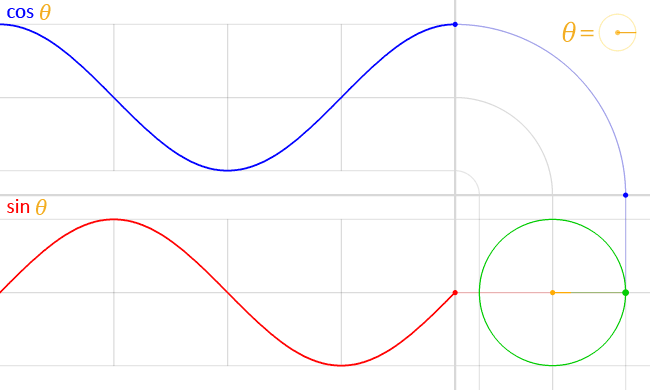Fitxer:Circle cos sin.gif
Circle_cos_sin.gif (650 × 390 píxels, mida del fitxer: 517 Ko, tipus MIME: image/gif, en bucle, 60 fotogrames, 6,0 s)
Historial del fitxer
Cliqueu una data/hora per veure el fitxer tal com era aleshores.
| Data/hora | Miniatura | Dimensions | Usuari/a | Comentari | |
|---|---|---|---|---|---|
| actual | 02:32, 24 juny 2014 |  | 650 × 390 (517 Ko) | LucasVB | Reverted to version as of 15:59, 16 March 2014 |
| 01:00, 23 juny 2014 |  | 390 × 650 (390 Ko) | SteinsplitterBot | Bot: Image rotated by 90° | |
| 17:59, 16 març 2014 |  | 650 × 390 (517 Ko) | LucasVB | {{Information |Description ={{en|1=sin & cos}} |Source ={{own}} |Author =LucasVB |Date =2014-03-16 |Permission ={{PD-self}} |other_versions = }} Category:Trigonometry [[Category:Trigonometric funct... |
Ús del fitxer
La pàgina següent utilitza aquest fitxer:
Ús global del fitxer
Utilització d'aquest fitxer en altres wikis:
- Utilització a ar.wikipedia.org
- Utilització a beta.wikiversity.org
- Utilització a bn.wikipedia.org
- Utilització a cs.wikipedia.org
- Utilització a de.wikipedia.org
- Utilització a en.wikipedia.org
- Utilització a en.wikibooks.org
- Utilització a eu.wikipedia.org
- Utilització a fr.wikipedia.org
- Utilització a id.wikipedia.org
- Utilització a it.wikiversity.org
- Utilització a ja.wikipedia.org
- Utilització a ja.wikibooks.org
- Utilització a ko.wikipedia.org
- Utilització a nl.wikipedia.org
- Utilització a ru.wikipedia.org
- Utilització a ru.wiktionary.org
- Utilització a shi.wikipedia.org
- Utilització a tr.wikipedia.org
- Utilització a uk.wikipedia.org
- Utilització a yi.wikipedia.org
- Utilització a zh-yue.wikipedia.org

